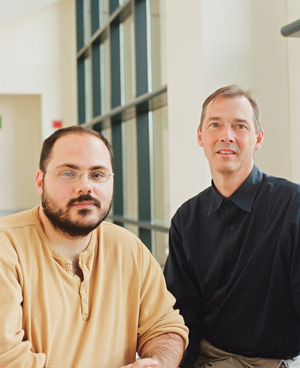An unexpected ingredient in Down syndrome research
Leslie Williamson |
|
 |
|
|
By KRISTA CONGER
Chocolate milk and peer pressure might seem unusual components of a successful experiment, but Fabian Fernandez knows better.
The fifth-year graduate student in psychiatry professor Craig Garner’s laboratory recently parlayed the unlikely duo into the first glimmer of hope for a drug treatment for Down syndrome.
It all started in the summer of 2003. “Craig said ‘How would you like to go on an adventure with me?’ ” Fernandez recalls. “I joked, ‘You know, I’m not Indiana Jones. I might be a liability going over the mountain.’” But when Garner, who had recently become co-director of the Stanford/Lucile Packard Children’s Hospital Down Syndrome Research Center, explained that the adventure was finding a way to treat Down syndrome, Fernandez was happy to oblige.
For about two months Fernandez delved into research on the biology of learning and memory. He read studies from the 1950s about a compound called pentylenete-trazole, or PTZ, that seemed to help elderly or mentally impaired people concentrate better. PTZ blocks the action of a brain chemical called GABA, which in turn blocks neural signals. He was intrigued — because it’s thought that Down syndrome patients have too much GABA-related inhibition, making it difficult to process information.
“In general, learning involves neuronal excitation in certain parts of the brain,” says Garner. “For example, caffeine, which is a stimulant, can make us more attentive and enhance learning. Conversely, alcohol or sedatives impair our ability to learn.”
But, like caffeine, too much PTZ can backfire: High doses can cause seizures. In fact, the FDA withdrew approval for the use of PTZ in humans in 1982 because it had no clear clinical benefit. That is, until Fernandez resolved to test PTZ’s effect in mice with Down syndrome symptoms.
His first challenge was to get the mice to take the drug voluntarily. “Stress itself affects cognition,” says Fernandez, “and force-feeding the mice would have been very stressful for them.” Simply mixing the drug into their regular rations wouldn’t work because they nibble all day. Fernandez needed to know exactly when the mice got the dose so he could time its effects.
That’s when he hit upon chocolate milk. Says Fernandez: “Mice love chocolate, vanilla and banana flavors, and they prefer milk to water. Water is blah.” He overcame any residual reluctance by providing the milk in a group setting. “It was a little like a Friday night party,” says Fernandez. “The animals who were drinking the milk and acting like ‘Yum, this is very tasty’ convinced the more suspicious animals to try it.” Once all the mice were eagerly drinking, Fernandez separated them and began the experiment — this time serving up individual portions of PTZ-laced chocolate milk in tiny bowls handcrafted from Eppendorf test tube caps.
The effects were dramatic. Fernandez found that treating the mice with PTZ once a day for about two and a half weeks significantly improved their ability to identify novel objects and navigate a maze — tasks that simulate difficulties faced by people with Down syndrome. What’s more, the gains lasted for months after the treatment was discontinued.
“Somehow the drug treatment creates a new capacity for learning,” says Garner. And in case you’re wondering: Chocolate milk alone doesn’t do the trick.Comments? Contact Stanford Medicine at

